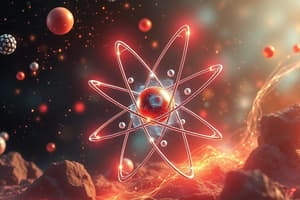Podcast
Questions and Answers
Which of the following statements accurately reflects Dalton's Atomic Theory?
Which of the following statements accurately reflects Dalton's Atomic Theory?
- Matter is composed of elements, not atoms.
- Atoms of the same element are identical. (correct)
- Atoms of different elements are identical in mass and properties.
- Atoms can be further subdivided into smaller particles.
According to Aristotle, all matter is composed of indivisible particles called atoms.
According to Aristotle, all matter is composed of indivisible particles called atoms.
False (B)
In Rutherford's model of the atom, what occupies the majority of the volume of the atom?
In Rutherford's model of the atom, what occupies the majority of the volume of the atom?
empty space
Thomson's plum pudding model proposed that atoms consist of a positively charged substance with negatively charged _________ embedded within it.
Thomson's plum pudding model proposed that atoms consist of a positively charged substance with negatively charged _________ embedded within it.
Match the scientist with their atomic model:
Match the scientist with their atomic model:
Which model proposed that the positive and negative charges are embedded within it?
Which model proposed that the positive and negative charges are embedded within it?
Democritus proposed that matter was made up of four natural elements.
Democritus proposed that matter was made up of four natural elements.
Who wrote 'A New System of Chemical Philosophy'?
Who wrote 'A New System of Chemical Philosophy'?
Flashcards
Democritus's Atom
Democritus's Atom
The smallest, indivisible unit of matter (from the Greek 'atomos').
Aristotle's Elements
Aristotle's Elements
Matter is composed of four elements: Earth, Water, Fire and Air
Dalton's Atomic Theory
Dalton's Atomic Theory
All matter is made of indivisible atoms; atoms of the same element are identical; atoms combine to form compounds.
Dalton's Model
Dalton's Model
Signup and view all the flashcards
Thomson's Plum Pudding Model
Thomson's Plum Pudding Model
Signup and view all the flashcards
Rutherford's Nuclear Model
Rutherford's Nuclear Model
Signup and view all the flashcards
Bohr's Planetary Model
Bohr's Planetary Model
Signup and view all the flashcards
Nucleus
Nucleus
Signup and view all the flashcards
Study Notes
- Atomic Theory and the Scientists - 3rd Quarter Lesson 1
Early Theories of the Atom
- Democritus believed that the atom came from the Greek word "Atomos," and was an indestructible and indivisible particle.
- Aristotle believed matter was made up of four natural elements.
- Air
- Fire
- Water
- Earth
Atom Structure
- Nucleus: contains protons and neutrons
- Proton: positively charged particles
- Neutron: particles with no charge
- Electron: negatively charged particles
Early Theories of the Atom
- John Dalton wrote "A New System of Chemical Philosophy"
Atomic Theory States
- All matter is made of tiny, indivisible particles called atoms.
- An adult human body is made up of approximately 7 octillion atoms.
- This is 7,000,000,000,000,000,000,000,000
- An adult human body is made up of approximately 7 octillion atoms.
Atomic Theory States
- The atoms of an element are all the same.
- The atoms of different elements vary from one another.
- Aluminum is 2,8,3
- Silver is 2,8,18,18,1
- Platinum is 2,8,18,32,17,1
- Gold is 2,8,18,32,18,1
- Atoms may form compounds when they combine. -. Water, oxygen, hydrogen
Atom Models Through History
- John Dalton: Solid Sphere Model-atoms are indivisible
- J.J. Thomson: Plum Pudding Model-positive and negative charges are embedded within it.
- Ernest Rutherford: Nuclear Model-electrons orbiting in a path around the positive charges
- Niels Bohr: The Planetary Model-electrons are arranged in concentric circular orbits around the nucleus
Studying That Suits You
Use AI to generate personalized quizzes and flashcards to suit your learning preferences.




